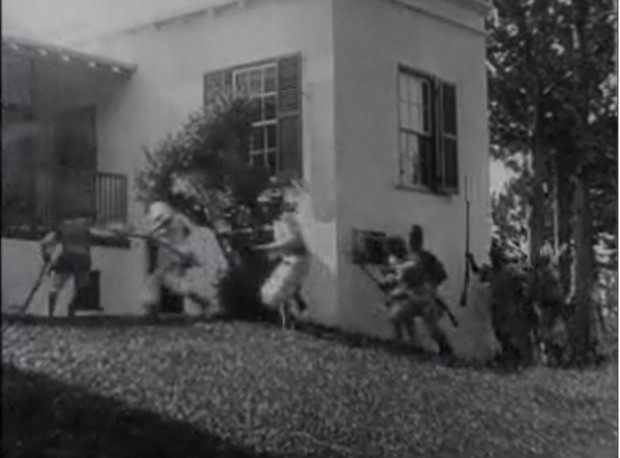Video: 100 Year Old Film Made In Bermuda
Bermuda doubled for a besieged 19th century city in British India in a short historical film shot on the island one hundred years ago.
Made in Bermuda in 1912, “The Relief of Lucknow” was produced by Thomas Edison’s pioneering East Coast film company for the British market and about ten minutes of the movie’s Bermuda location footage survives today. The historical recreation’s original running time was close to a half hour.
The previous year the Edison Company began to make films on specifically European themes to increase sales in Britain. A 1911 adaption Alfred Lord Tennyson’s poem “The Charge of the Light Brigade” shot in Cheyenne, Wyoming depicted the Battle of Balaclava during the Crimean War [1853-1856] as a tale of British loyalty and sacrifice had proved a box office sensation in the UK.
Indian nationalist rebels on the attack in “The Relief of Lucknow”
“The Relief of Lucknow” was a follow-up. During the Indian Mutiny of 1857, rebel forces had laid the British garrison based at the Residency in Lucknow. Lucknow was eventually relieved, first by forces under the command of Sir Henry Havelock and Sir James Outram, followed by a stronger force under Sir Colin Campbell.
The company had started sending actors and personnel to shoot films in outdoor locations away from its New Jersey studio and Serle J. Dawley — director of “The Charge of the Light Brigade” — led the trip to Bermuda.
Taking advantage of the island’s good weather, varied locations and proximity to New Jersey, Dawley shot a number of short films — 20 minutes to half-an-hour long — here in the spring of 1912.
Aside from “The Relief of Lucknow”, other titles included perhaps the earliest version of Robert Louis Stevenson’s classic “Treasure Island” and a drama called “The Lighthouse Keeper’s Daughter.”
Those films are now considered lost like more than 90 percent of the movies shot during the pre-1927 silent era.
“The Relief of Lucknow” was filmed in Bermuda because the island offered the advantages of tropical scenery and the presence of the 2nd Battalion of the Queen’s Own Regiment, then stationed here.
British troops attack Indian rebels in “The Relief of Lucknow”
The film was made to commemorate the 51st anniversary of the Indian Mutiny, also referred to as the Uprising or, by Indian nationalists, as India’s first War of Independence.
Sepoys — Indian troops of the British East India Company — were the visible face of the uprising, but acts of bloody rebellion by civilians, peasants, and landed gentry against the British and their supporters cut across India’s Upper Gangetic Plain.
There were long and short-term motives for the Uprising, ranging from the Company’s brutal taxation policies, its rapid annexation of land by flouting agreements with Indian Princely allies, and recent anger over the Enfield rifle, rumored to use cartridges greased with pig and beef lard, which gave offense to Muslims and Hindus alike.
Significantly, the events of 1857 ended the British East India company’s rule and initiated the British Crown’s official control over India’s revenue and governance.
Lucknow was the capital of Awadh, and is located in the modern Indian state of Uttar Pradesh. During the Mughal era, it was ruled by Shi’ite Nawabs and renowned for its tradition of dance, music, architecture and poetry.
“The Relief of Lucknow” was shot at various locations around the island including Villa Monticello in Flatts Village — a special effects charge used during a battle scene accidentally blew the verandah off the building.
Surviving footage from “The Relief Of Lucknow”, shot on location in Bermuda in 1912
Read More About
Category: All, Entertainment, Films/Movies, History, Videos



